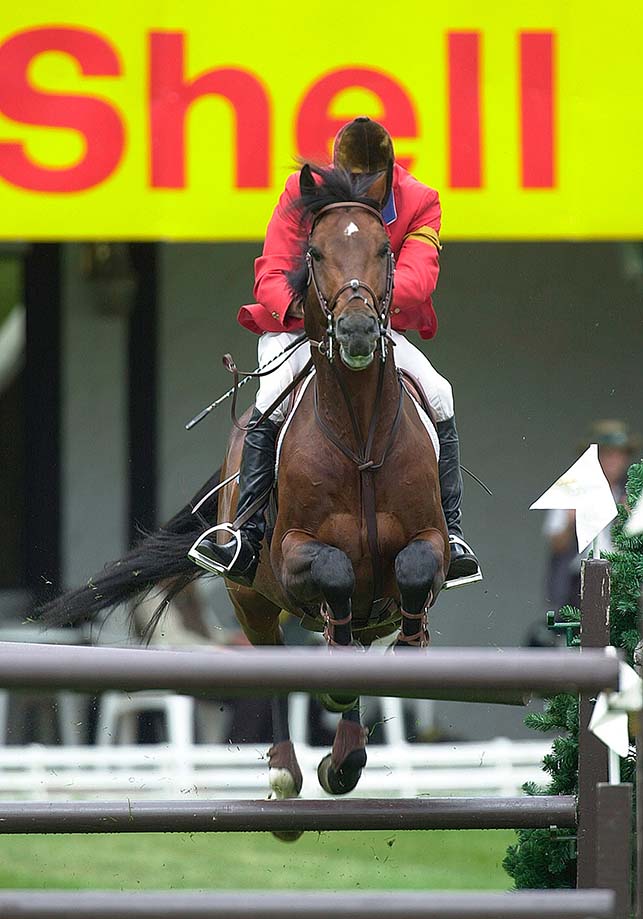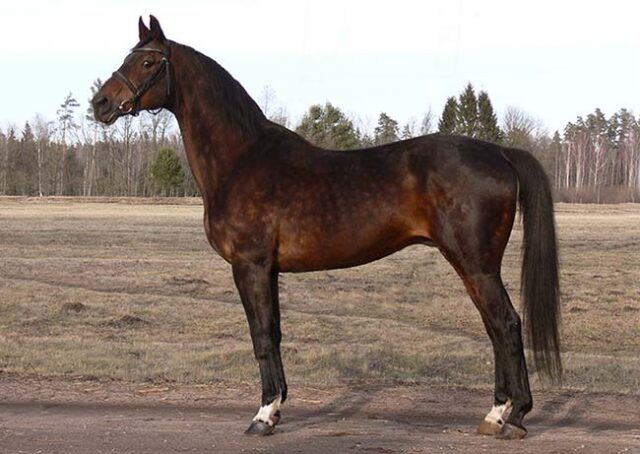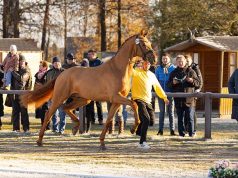By Elena Zobova
Photography: Elena Zobova, Nemuno horse stud, Peter Llewellyn
Horalas belongs to a very select group of stallions who were born outside Germany but approved by the Trakehner Verband on the basis of their performance records. Horalas competed against the best horse and rider combinations in the world at the highest level like no other Trakehner since the days of Abdullah.
Horalas was retired almost at the peak of his jumping career with no health or injury issues, but following the death of his owner, Diane Ruishing. The stallion possessed great power and willingness to perform. Some breed experts were quoted as saying his technique was not great, but he fully compensated for this deficiency with an excellent competition mentality. There is no doubt that Horalas passed on his jumping ability to all of his offspring.
His story, however, began on March 17, 1992, at the famous Nemuno horse stud in Lithuania. The earth here is sandy, the sun is warm, and the skies are wide. Ties between the Nemuno horse stud and the main Trakehner stud reach back to the early days of the 20th century, when the foundation Trakehner stallion Dampfross (1916, Dingo - Laura x Passvan) was born there, and the pedigree of Horalas is a great example of this connection. His heritage includes many of Trakehner’s most famous foundation sires like Pilger, Pythagoras (the son of the above-mentioned Dampfross), Tempelhüter, and Kupferhammer.
Trakehner horses were bred for many years in the windy meadows of the Nemunas river, and a number competed successfully in jumping arenas outside Lithuania. To name a few: Steps Helsinki/ex Helsinkis (1989, Forpost - Higiena x Hromogen) ridden by Britain’s John Whitaker; Traxdata Mulligan/ex Esopas (1988, Cheopsas - Ellada x Privet) for Ireland with Peter Charles; and the stallions Hamanas (1984, Gret - Habanera x Hromogen) and Hepatitas (1987, Forpost - Habanera x Hromogen) who both jumped under the Norwegian flag.
Not a typical Trakehner
Horalas was the very first son of Hipogeja and Veimaras. He was not special or somehow different from other colts of his age. His head was a bit longer than normal, legs were not completely straight. Large-boned, narrow, a bit skinny, but already showing an elegant and impressive disposition. At that time it never occurred to anyone that this bay stallion would influence Trakehner breeding throughout the whole world.
Three years flew by very quickly and Horalas was put under saddle, but due to his untypical Trakehner conformation he wasn’t included in the young breeding stallions’ group. According to the Ramune Jasiene, the breeding manager of the Nemuno stud; “Many times, going through the stable we stopped at Horalas’s box and discussed the future of the stallion. Already at his young age Horalas had very powerful jump, and his pedigree was very interesting, but at that time our horse stud manager and the Trakehner breeder with the most say, Dobilas Obelenis told us all the time, ‘let’s wait a while’.”

Hap Hansen (USA)
Two sides of the same coin
On the flip side of the coin, Horalas’s trainer was the talented rider and horseman Rimas Rimkus, who had been riding horses since the age of 12 and had his own opinion. “It is necessary for Horalas to cover as many mares as possible. From this outstanding stallion with such power over the fence, who never refuses to jump, who is eager to work
The results of Horalas and Rimas Rimkus in the showjumping ring were remarkable; twice winning the national championship title, then victory in the World Cup qualifying Grand Prix of Vilnius in 2001.
Finally, at the age of five, it was decided that Horalas would cover 13 mares, then 20 the following year. But in March 1998 Lars Gehrmann from the Trakehner Verband arrived at the Nemuno horse stud and his decision was rather heart-breaking: “Horalas has to be used very carefully and only with a limited number of mares whose jumping abilities have to be improved.” He was granted up to five mares in the first year, reduced to just three the following year... To read the complete article you need to be a subscriber
CLICK HERE TO SUBSCRIBE TO BREEDING NEWS
SUBSCRIBERS CAN READ THE COMPLETE ARTICLE BY LOGGING IN AND RETURNING TO THIS PAGE




